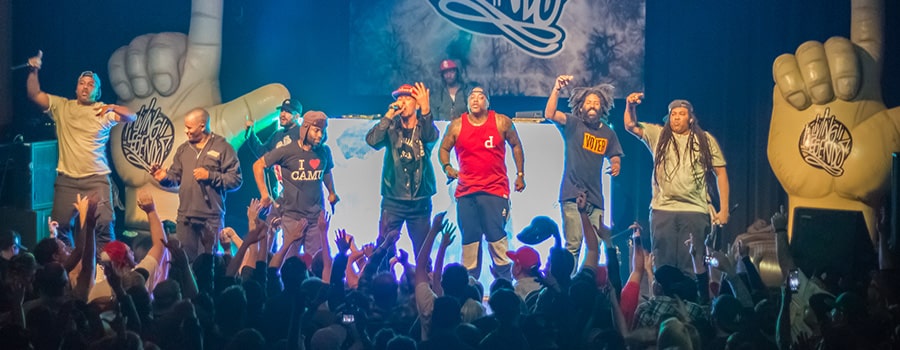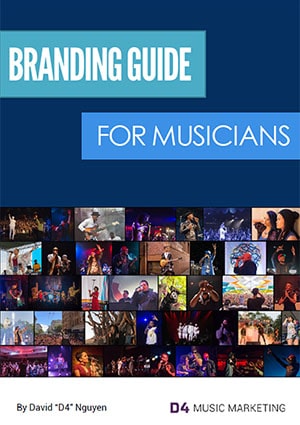
In today’s content-saturated world, getting your music heard and building a fanbase is no easy task. But have you ever considered how much harder it would be to build a career as an independent artist without the internet and social media? Or without powerful devices that let you conveniently record and produce music from home?
In this blog, I want to share some key lessons we can learn from DIY independent music artists from the 1990s, specifically in the underground hip-hop scene in the United States. This was an interesting time in history because new technology (the internet, email, CDs) was being introduced to the masses that would later have a positive impact on independent artists. It helped level the playing field with the music gatekeepers beginning in the 2000s and beyond. Even if you don’t listen to or make hip-hop/rap music, you should be able to learn something and gain perspective that applies to you today.
The Back Story / Context for this Topic
Feel free to skip down to the next section if you want to get right into the lessons. I share some historical context about this topic and include my personal connection to the independent hip-hop scene beginning in the early 2000s.
Compared to present times, a lot has changed since the 1990s regarding the music industry, technology and even culture.
Before the internet became a household consumer good, many soon-to-be-big-name artists across the U.S. hustled from the ground up starting in their local scene and launching their music careers. Many stayed independent while others signed record deals or started their own labels.
For these hip-hop artists, their origins often involved selling albums/mixtapes out of their trunks or backpacks on the streets to random passersby. Instead of recording demo tapes to submit to the major labels, they dubbed their tapes or burned CDs to sell directly to customers in their local area.
As the internet became more accessible in households, we saw the DIY independent music scene really flourish in the early 2000s and into what we have today.
Yes, the gradual decline of CD sales due to the rise of online music “piracy” also started around this time and would become a major road bump for independent artists. However, you can argue that illegal file-sharing networks (Napster, LimeWire) also helped spread their music further to new fans who would eventually buy their merch and pay to see them live. Successful independent artists like Immortal Technique embraced the technology and encouraged people to “steal all of his music”.
This DIY movement in music was important because it challenged the commonly-held belief that you need a major label to grow a fan base and make a living as an independent musician.
I’ve been fortunate enough to work with some of these independent artists from this period and see how they think and operate. These are the same underground hip-hop artists I listened to during my college years and became fans of for over 20 years. My passion and understanding of independent music is based on being a fan of their work.
I was first inspired to write about this topic when I saw independent rapper The Grouch on the SteeBee WeeBee show a few years ago. During a time when the internet was still in its infancy stage, The Grouch shared some cool details in this interview about what it was like to promote and sell your music independently before the internet.
The Grouch is a hip-hop artist originally from Oakland who has been putting out music independently for over 30 years. He is a part of a bigger hip-hop crew Living Legends. My client Eligh is a part of the same crew and makes up the other half of the long-time recording duo The Grouch & Eligh.
Among their music peers, the Living Legends crew in California were considered the most DIY/independent hip-hop artists at the time. They literally handle everything themselves from throwing their own shows, recording their own music from home, making their own tapes and selling on the streets.
It is said that Master P, one of the most successful independent hip-hop artists and entrepreneurs, actually learned and was inspired by Bay Area artists like Too Short and E-40 who in turn inspired the likes of The Grouch and Eligh.
Most of you reading this probably don’t listen to underground hip-hop, which is okay. I’ll be referring to hip-hop artists because that’s the scene I got into in college and shaped my identity. As I have written on my About page, it was my passion for underground hip-hop that ultimately led me to create a music blog for independent artists in the first place.
Although a lot has changed since then, I wanted to share 9 important lessons from the 1990s independent music grind that still apply today. You might not listen to hip-hop, but these lessons can be applied to any genre of music. After all, we’ve seen the DIY ethos practically start with punk rock subcultures as early as the 1960s.
For further visual context, there’s an excellent Netflix series called Hip Hop Evolution that covers the beginning stages of the genre and how many artists in different parts of the U.S. got started independently. I highly recommend it as I think it’s important to understand the history of independent music if you’re trying to make it as an independent.
1. Selling physical products / merch is essential.
The biggest source of income for independents during the 1990s was selling physical music, like cassette tapes and later CDs. The larger profit margins from selling these items were what really allowed independent artists to sustain themselves financially.
One of the big pioneers of this independent spirit of selling out of the truck was Oakland rapper Too Short who offered to record a personalized shoutout on his music tapes in the 1980s. He charged $20 for this custom tape and it blew up.
In Houston, Texas, DJ Screw would sell $15,000 worth of mixtapes a day in the mid-1990s. He made seven figures a year selling tapes out of his house, his car trunk and at car shows. In 1998, he opened a shop just to sell his mixtapes!
As for The Grouch, he talked about how he would go to local record shops around the San Francisco Bay Area in the late 1990s and sell a bulk of his CDs at $10 a piece. He would make his rounds to hit up each record store and make about $7,000 each stop and as high as $11,000. His music was flying off shelves so these record shops had no problem writing these big checks.
Getting paid opportunities to do live shows wasn’t as accessible for independent artists back then. So if you were relatively unknown and not getting airplay on the radio, you had to have physical products to sell.
The need to sell physical products is no different in today’s music climate. Although with streaming platforms, the average fan doesn’t need CDs, vinyl and cassette tapes to listen to music. But the need to have some kind of physical product to sell is still necessary.
This is where understanding branding comes in. You need to know what merch to make for your target audience. After all, merchandise is the physical extension of your brand and you want fans to consume it as a way to support what you do.
One of the big challenges with merch for independent artists is having the money to front for the production. Making products in bulk like vinyl, CDs, shirts and sweatshirts can be costly.
Thanks to advancements in technology, dropshipping services like Printful, make it easier for creatives to sell merchandise without any upfront capital or pay any costs to get items made.
2. Keep pushing out music – make more music, more money opportunities.
This should come as no surprise. The more music you put out, the more opportunities you have to make money from it and grow an audience. Specifically, more physical products to sell. Obvious right?
As mentioned earlier, the profit margins from CDs during this time were what allowed independent artists to flourish financially.
Within a major label system, there can be a lot of bureaucracy and politics when putting out music. For independents, there’s no such thing so use it to your advantage.
The Grouch knew he couldn’t sell 100k copies of an album without the financial backing or advance a typical record label could provide. But he would have a better chance of selling 10k copies of 10 different CDs.
Over 25 years later, these underground artists have large catalogs with over 20 albums worth of music. To put into perspective, just with The Grouch and Eligh alone, they have 40 released albums combined, which doesn’t include any albums as a crew and features for other artists.
Was flooding the market with too much music a bad thing? Nope, fans ate it all up. Even today, no fan is going to tell their favorite artists to stop putting out so much music. It’s a necessity for emerging artists in today’s music industry to release music more frequently and consistently.
Nowadays, with relatively less demand for products like CDs and tapes, putting out a lot of music isn’t necessarily going to earn you more money with streaming as the preferred method for music consumption. With streaming royalties so low (roughly 3,000 streams will be equivalent to what you make from selling a $15 CD), the average independent artist can’t sustain from it alone.
However, putting out more quality music has an exponential effect. Pushing out more songs won’t necessarily mean you’ll generate cash in the short term, but each one will give you a chance to build off momentum with proper marketing. It gives you more “content” to promote yourself and get discovered on social media.
Even though not all songs will be a hit, they will be added to your back catalog and accumulate more streams over time as your fan base grows. As the saying goes, old music is always new to someone. And if one of those songs takes off or goes viral, it’ll definitely help lift the rest of your discography.
3. Have the ability to record and make music from home.
The ability to make music at home is drastically different than how it was in the 1990s. Equipment was more expensive, and it sounded much more complicated using things like an ASR-10 and SP-1200 sampler.
Recording and producing music at a professional studio is pricey. If you have the resources and space to do it from home, you can save a lot of money and potentially accomplish a lot more.
For The Grouch, he was doing 4 track recordings at home and using music samplers to make beats. In the 1990s, you didn’t have affordable DAWS (Digital Audio Workstations) on portable laptops and free YouTube education on how to use them.
A lot of these hip-hop artists at this time were teenagers so buying $2,000 – $3,000 recording equipment was relatively more expensive to them.
Take advantage of the technology today to record and make music from home. Russ is a great example of a modern DIY artist. In this video, he talks about putting the “gym” at home.
You may still use a professional recording studio to record the final mixes, but the early demos and mixes can start from home to save money.
4. Word-of-mouth is still important. Otherwise, meet your fans where they’re at.
Back in the days, you discovered new music from either the radio, magazines, TV or from a friend. Your friend likely gave you a dubbed tape or a burned CD from another friend’s sister’s cousin’s older brother.
Today, word-of-mouth is still a popular way of learning about new artists whether it’s a friend making an in-person recommendation or you seeing a social media post about it.
On the flip side, getting exposure to new potential fans in the 1990s was a different story. Because many of these local artists weren’t getting coverage from traditional media like TV, magazines or radio, they had to depend on doing things in person and hopes that would lead to word of mouth recommendations.
For the Living Legends crew, they took it to the next level. The Grouch talked about how they would save up money and periodically check flight prices at a local travel agency. The tactic was to find popular artists in the same lane and physically follow their tour routes. They gathered up whatever money they could scrap together to fly to different cities (and even countries like the UK, Germany and Japan) to promote their music and sell tapes outside of these shows. Because of their persistence, these artists would often let them be the openers and get direct exposure to their target audience.
It was a totally different time culturally, where now soliciting random strangers on the streets is no longer as effective today.
Fortunately, you can get people’s attention and put your music in front of people without having to do any traveling because of the internet. We now have the option of running hyper-targeted Instagram and TikTok Ads to fans of artists with a similar sound from the comfort of our homes.
5. Use your money wisely. Investing back into your music career.
You hear it all the time. Treat your music career as a business because that’s what it is. For businesses to grow, you need to invest money into it and not blow the money you earn on things that won’t further your career.
When The Grouch was a teen, his day job was delivering pizza. The first day he got a credit card, he maxed it out as you would expect a teen would do.
You might think it was for clothes, going out with friends or some form of entertainment. Not at all. He bought an ASR-10 to make music from home. Although he went into debt, it was an important investment for his music career and his close peers.
To tie in with the previous point, The Grouch would grind by selling tapes on the streets so his crew could have money to buy plane tickets to promote their music at shows from signed groups like The Pharcyde. It was well worth the investment as they eventually got noticed and opened for these artists. This is a great example of reinvesting the money you make for the long-term growth of your career.
You can argue that there are a lot more distractions to waste your money today and that the cost of living is higher, but if you really believe in your music, you’ll make the right decisions. For more on this, I wrote a blog on the top things you want to invest back into your music business.
6. Team up with other independents.
Being an independent artist doesn’t mean you have to do it all by yourself. Being a part of a crew, artist collective and/or community is a big advantage.
I’ve talked about having a community mindset in a previous blog and it is certainly applicable here. A lot of these independent artists worked together with others in the same area or city. Many developed their own crews or collectives so they could collaborate and even release albums together. It made a lot of sense back then because resources and knowledge were limited and you were more likely to get further by teaming up with others.
The Grouch and Eligh are a part of the California hip-hop crew The Living Legends. Crews like this were very common all over the United States in the underground scene.
Being a part of a music crew may be more of a “hip-hop” thing, but you can still incorporate this concept even if you do any other type of music. Find other like-minded artists you can befriend and collaborate with musically. Maybe even become really good friends. It’s all about building a network with a community-oriented mindset.
7. Fill a need that’s lacking or do it better. Innovate.
One of the reasons why these DIY artists were able to win over fans is because they offered something unique or different. These underground movements were often providing alternative sounds the mainstream didn’t want to shine a light on, hence underground. For many, it was a countercultural movement in music.
A lot of these Bay Area hip-hop crews had artists representing different types of styles, voices, identities and personalities that attracted those who didn’t feel they could resonate with what was being offered in commercial music channels.
On the west coast for example, the dominant subgenre played on mainstream media was gangster rap that glorified things like drugs, objectification of women, violence and money.
Music from California underground crews like The Living Legends and Hieroglyphics and SoleSides (Quannum Projects) was quite the opposite. Their songs had a more lighthearted vibe with relatable topics. It had substance that the average person could relate to. More importantly, they were innovative with their art.
Here’s an audio clip with Andre 3000 of Outkast, who currently has the best selling rap album of all time, talking about how influential and innovative the Hieroglyphics Crew was on him personally and the impact it had for hip hop during the 1990s.
Of course, you don’t have to be a gangster to like or listen to gangster rap, but these independent artists from this time provided multiple alternatives to what was readily available on the radio or TV.
To be fair, it’s a bit harder to fill a need in music today because of how the internet has already opened so many doors for artists around the world that typically wouldn’t have been given a chance by a major label. It doesn’t help that the 1990s wasn’t as musically diverse and intertwined as it is today. But it’s not impossible to create your own lane today by doing something different as we’ve seen artists like Post Malone, Lil Nas X and Hobo Johnson do it in more recent times.
8. Be adaptable, diversify and experiment.
Society, culture and technology are always changing so don’t ever get complacent with what currently works.
The biggest source of income for independents in the 1990s were tapes and CDs. Touring was optional to bring extra income and engage with fans. The rise of MP3s and music piracy would eventually disrupt this business model dependent on record sales and begin a drastic shift towards digital music.
The Grouch says he was a go-with-the-flow guy so he wasn’t opposed to this change. Although it affected the money he would make in the short term, it also would help get his music out to more people and created a demand for other income sources down the line.
As an independent artist, you’re generally going to be more nimble, giving you the advantage to adapt more easily. You should be looking for the next big thing to give you an edge. This line of thinking also applies to social networks, platforms and apps. MySpace was once the top social media platform for music, but others like Facebook, Instagram and YouTube would overtake its place.
9. Embrace the entrepreneurial spirit. Develop your hustle and start the grind.
Despite how accessible it is to build a music career independently today, there’s still a desire to get signed by a record label. Why? Because there’s a lot of work, development and resources that goes into being a full-time artist that many don’t want to deal with.
Regardless if you want to earn a record deal or not, you still need to show you can build momentum with your music on your own. Since artist development isn’t required to start, labels want to see proof of concept and major buzz before even considering it. For artists, this requires an entrepreneurial mentality and dedication to building a business.
All these independent artists I’ve mentioned so far, and many others during these times, embraced the entrepreneurial spirit. Chances are they didn’t think of themselves as businessmen or entrepreneurs but that’s what they were. They got their hands dirty in the different aspects of the music business and made it work with the limited resources they had. Because they believed in their art, failure was not an option for them and they stayed persistent through any obstacles that came their way.
With so much competition today, it’s easy to get discouraged, especially when you’re not seeing much success early on. It’s up to you to develop yourself to become a well-rounded artist and business person. It starts with embracing the entrepreneurial spirit, having self-awareness and welcoming the inevitable challenges.
Conclusion
There’s always going to be a debate about which time period was actually harder to be an independent artist in.
Was it before the internet where it was more profitable selling tapes and CDs, but the potential for exposure and scalability was very limited?
Or in present times where income with music streaming is limited, but you have the ability to grow and scale your music worldwide with social media?
To me, the answer is obvious but I would love to hear what you think!







